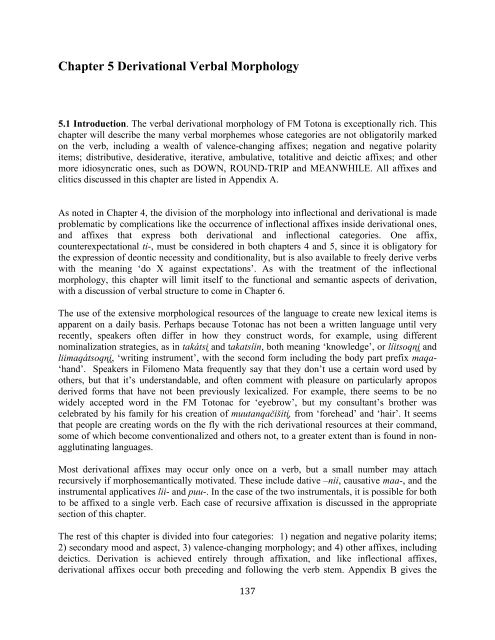The phonology and morphology of Filomeno Mata Totonac
The phonology and morphology of Filomeno Mata Totonac
The phonology and morphology of Filomeno Mata Totonac
Create successful ePaper yourself
Turn your PDF publications into a flip-book with our unique Google optimized e-Paper software.
Chapter 5 Derivational Verbal Morphology<br />
5.1 Introduction. <strong>The</strong> verbal derivational <strong>morphology</strong> <strong>of</strong> FM Totona is exceptionally rich. This<br />
chapter will describe the many verbal morphemes whose categories are not obligatorily marked<br />
on the verb, including a wealth <strong>of</strong> valence-changing affixes; negation <strong>and</strong> negative polarity<br />
items; distributive, desiderative, iterative, ambulative, totalitive <strong>and</strong> deictic affixes; <strong>and</strong> other<br />
more idiosyncratic ones, such as DOWN, ROUND-TRIP <strong>and</strong> MEANWHILE. All affixes <strong>and</strong><br />
clitics discussed in this chapter are listed in Appendix A.<br />
As noted in Chapter 4, the division <strong>of</strong> the <strong>morphology</strong> into inflectional <strong>and</strong> derivational is made<br />
problematic by complications like the occurrence <strong>of</strong> inflectional affixes inside derivational ones,<br />
<strong>and</strong> affixes that express both derivational <strong>and</strong> inflectional categories. One affix,<br />
counterexpectational ti-, must be considered in both chapters 4 <strong>and</strong> 5, since it is obligatory for<br />
the expression <strong>of</strong> deontic necessity <strong>and</strong> conditionality, but is also available to freely derive verbs<br />
with the meaning ‘do X against expectations’. As with the treatment <strong>of</strong> the inflectional<br />
<strong>morphology</strong>, this chapter will limit itself to the functional <strong>and</strong> semantic aspects <strong>of</strong> derivation,<br />
with a discussion <strong>of</strong> verbal structure to come in Chapter 6.<br />
<strong>The</strong> use <strong>of</strong> the extensive morphological resources <strong>of</strong> the language to create new lexical items is<br />
apparent on a daily basis. Perhaps because <strong>Totonac</strong> has not been a written language until very<br />
recently, speakers <strong>of</strong>ten differ in how they construct words, for example, using different<br />
nominalization strategies, as in takátsi" <strong>and</strong> takatsíin, both meaning ‘knowledge’, or líitsoqn"i" <strong>and</strong><br />
liimaqátsoqn"i", ‘writing instrument’, with the second form including the body part prefix maqa-<br />
‘h<strong>and</strong>’. Speakers in <strong>Filomeno</strong> <strong>Mata</strong> frequently say that they don’t use a certain word used by<br />
others, but that it’s underst<strong>and</strong>able, <strong>and</strong> <strong>of</strong>ten comment with pleasure on particularly apropos<br />
derived forms that have not been previously lexicalized. For example, there seems to be no<br />
widely accepted word in the FM <strong>Totonac</strong> for ‘eyebrow’, but my consultant’s brother was<br />
celebrated by his family for his creation <strong>of</strong> muutanqa$i#iti", from ‘forehead’ <strong>and</strong> ‘hair’. It seems<br />
that people are creating words on the fly with the rich derivational resources at their comm<strong>and</strong>,<br />
some <strong>of</strong> which become conventionalized <strong>and</strong> others not, to a greater extent than is found in nonagglutinating<br />
languages.<br />
Most derivational affixes may occur only once on a verb, but a small number may attach<br />
recursively if morphosemantically motivated. <strong>The</strong>se include dative –nii, causative maa-, <strong>and</strong> the<br />
instrumental applicatives lii- <strong>and</strong> puu-. In the case <strong>of</strong> the two instrumentals, it is possible for both<br />
to be affixed to a single verb. Each case <strong>of</strong> recursive affixation is discussed in the appropriate<br />
section <strong>of</strong> this chapter.<br />
<strong>The</strong> rest <strong>of</strong> this chapter is divided into four categories: 1) negation <strong>and</strong> negative polarity items;<br />
2) secondary mood <strong>and</strong> aspect, 3) valence-changing <strong>morphology</strong>; <strong>and</strong> 4) other affixes, including<br />
deictics. Derivation is achieved entirely through affixation, <strong>and</strong> like inflectional affixes,<br />
derivational affixes occur both preceding <strong>and</strong> following the verb stem. Appendix B gives the<br />
! "'+!

















